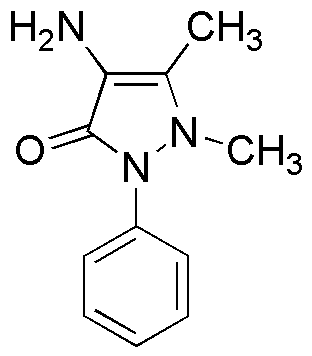4-Aminoantipyrine is widely utilized in research focused on
- Analytical Chemistry: It serves as a reagent in colorimetric assays for the determination of various substances, including glucose and uric acid, making it valuable in clinical laboratories.
- Pharmaceutical Development: This compound is used in the synthesis of analgesic and anti-inflammatory drugs, contributing to pain management therapies.
- Biochemical Research: It acts as an important tool in studying enzyme activity, particularly in the investigation of peroxidase enzymes, which are crucial in various biological processes.
- Environmental Monitoring: 4-Aminoantipyrine is utilized in the detection of pollutants in water samples, helping industries comply with environmental regulations.
- Food Industry: It is applied in the analysis of food products for the presence of certain additives and contaminants, ensuring safety and quality in food supply chains.
General Information
Properties
Safety and Regulations
Applications
4-Aminoantipyrine is widely utilized in research focused on
- Analytical Chemistry: It serves as a reagent in colorimetric assays for the determination of various substances, including glucose and uric acid, making it valuable in clinical laboratories.
- Pharmaceutical Development: This compound is used in the synthesis of analgesic and anti-inflammatory drugs, contributing to pain management therapies.
- Biochemical Research: It acts as an important tool in studying enzyme activity, particularly in the investigation of peroxidase enzymes, which are crucial in various biological processes.
- Environmental Monitoring: 4-Aminoantipyrine is utilized in the detection of pollutants in water samples, helping industries comply with environmental regulations.
- Food Industry: It is applied in the analysis of food products for the presence of certain additives and contaminants, ensuring safety and quality in food supply chains.
Documents
Safety Data Sheets (SDS)
The SDS provides comprehensive safety information on handling, storage, and disposal of the product.
Product Specification (PS)
The PS provides a comprehensive breakdown of the product’s properties, including chemical composition, physical state, purity, and storage requirements. It also details acceptable quality ranges and the product's intended applications.
Certificates of Analysis (COA)
Search for Certificates of Analysis (COA) by entering the products Lot Number. Lot and Batch Numbers can be found on a product’s label following the words ‘Lot’ or ‘Batch’.
*Catalog Number
*Lot Number
Certificates Of Origin (COO)
This COO confirms the country where the product was manufactured, and also details the materials and components used in it and whether it is derived from natural, synthetic, or other specific sources. This certificate may be required for customs, trade, and regulatory compliance.
*Catalog Number
*Lot Number
Safety Data Sheets (SDS)
The SDS provides comprehensive safety information on handling, storage, and disposal of the product.
DownloadProduct Specification (PS)
The PS provides a comprehensive breakdown of the product’s properties, including chemical composition, physical state, purity, and storage requirements. It also details acceptable quality ranges and the product's intended applications.
DownloadCertificates of Analysis (COA)
Search for Certificates of Analysis (COA) by entering the products Lot Number. Lot and Batch Numbers can be found on a product’s label following the words ‘Lot’ or ‘Batch’.
*Catalog Number
*Lot Number
Certificates Of Origin (COO)
This COO confirms the country where the product was manufactured, and also details the materials and components used in it and whether it is derived from natural, synthetic, or other specific sources. This certificate may be required for customs, trade, and regulatory compliance.


